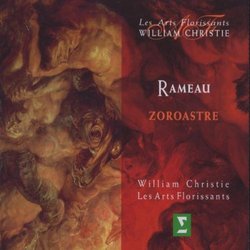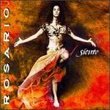| All Artists: Jean-Philippe Rameau, William Christie, Les Arts Florissants, Mark Padmore, Nathan Berg, Gaëlle Mechaly, Anna Maria Panzarella, Stephanie Revidat, Matthieu Lécroart, François Bazola Title: Rameau - Zoroastre / Padmore · Berg · Mechaly · Panzarella · Lecroart · Bazola · Bonnet · Revidat · Les Arts Florissants · Christie Members Wishing: 0 Total Copies: 0 Label: Erato Release Date: 4/15/2003 Genre: Classical Styles: Opera & Classical Vocal, Historical Periods, Baroque (c.1600-1750), Symphonies Number of Discs: 3 SwapaCD Credits: 3 UPC: 809274318220 |
Search - Jean-Philippe Rameau, William Christie, Les Arts Florissants :: Rameau - Zoroastre / Padmore · Berg · Mechaly · Panzarella · Lecroart · Bazola · Bonnet · Revidat · Les Arts Florissants · Christie
 | Jean-Philippe Rameau, William Christie, Les Arts Florissants Rameau - Zoroastre / Padmore · Berg · Mechaly · Panzarella · Lecroart · Bazola · Bonnet · Revidat · Les Arts Florissants · Christie Genre: Classical
While Freemasonry's secrecy has always aroused distrust, its enlightened principles and belief in virtue, liberty, fraternity, and equality have attracted large numbers of intellectuals and artists; one of its most famous ... more » |
Larger Image |
CD DetailsSynopsis
Amazon.com While Freemasonry's secrecy has always aroused distrust, its enlightened principles and belief in virtue, liberty, fraternity, and equality have attracted large numbers of intellectuals and artists; one of its most famous adherents was Mozart. However, his opera The Magic Flute was not the first to be inspired by its teachings but was preceded in 1749 by Rameau's Zoroastre. Its initial reception was so cool that Rameau and his librettist, Louis de Cahusac (a prominent Mason) undertook extensive revisions. The new version was produced--by coincidence or fate?--in 1756, the year of Mozart's birth, and became a great success. The opera is based on the struggle between good and evil, light and darkness, enlightenment and ignorance, personified by Zoroastre, the Persian religious reformer, and Abramane, an ambitious sorcerer, servant of the Evil Spirit. The human element (strengthened in the second version) is represented by two princesses, rivals for the Bactrian throne and Zoroastre's love; since one of them is in league with Abramane, the outcome is not in doubt. As in the Magic Flute, the music's the thing, and it is great, creating character, atmosphere and contrast, painting almost visible images of disasters, ceremonies, and celebrations. The vocal writing is extremely difficult, florid, wide in tonal and expressive range; the tenor and soprano parts lie extremely high, the basses' extremely low. Secco and accompanied recitatives melt into each other and into meltingly beautiful lyrical and stirringly dramatic arias and ensembles. But perhaps it is the choruses, underlining, supporting, and commenting on the action, and the orchestral sections, including many wonderful ballets, that are most impressive. Rameau uses the instruments to evoke light and shade, joy and sorrow, hope and despair, juxtaposing and combining winds and strings for utmost color and contrast, and the players and choristers do full justice to his demands. Among the soloists, the sopranos' often unvibrated tone tends to get shrill; the men are all superb; Padmore stands out in the punishingly difficult role of Zoroastre. --Edith Eisler Similar CDs
|
CD ReviewsSpectacular in every sense of the word Kicek&Brys | USA/UK | 02/15/2005 (5 out of 5 stars) "Rameau couldn't help being a musical revolutionary. Perhaps the fact he was so far ahead of his time explains the extraordinary freshness his music seems to have in ours. Parisian audiences at the 1749 premiere of "Zoroastre", his fourth "tragedie lyrique", were just as puzzled as they had been at his first, "Hippolyte et Aricie", sixteen years earlier and the reception was lukewarm. Undeterred, the composer completely refashioned the opera in 1756 to produce the version presented here. It turns out to be a masterpiece. One of the things the original audience found hard to accept was the novelty of the story, which is derived neither from Clasical mythology nor Italian romantic epic. The opera is set in ancient Bactria, then part of the Persian empire, now part of modern Afghanistan. It concerns the efforts of the prophet Zoroaster to introduce a new religion celebrating goodness and light and to win the hand of Princess Amelite, heiress to the throne of the kingdom. Ranged against him are the evil sorcerer and tyrant Abramane, who derives his magic from the demonic forces of the old religion, and Erinice, another princess in love with Zoroaster, whose anguished dilemma whether to kill the hero or warn him of Abramane's plots make up a good deal of the drama. As Graham Sadler explains at length in the booklet notes, contemporaries immediately recognized the libretto as an allegory of the ideals of freemasonry, leading many later critics to decribe the opera as Rameau's "Magic Flute" (the similarity between the names Zoroastre and Sarastro is no coincidence), though you won't find any of the high jinks of Papageno More fancifully the opera has been described as Rameau's "Parsifal", a valid comparison if it refers to the way the struggle between light and darkness is reflected in the composer's orchestration, some of his most extraordinary. In the enchanter Abramane "Zoroastre" also has one of Baroque opera's most memorable villains, who expresses the Machiavellian credo that "Tous les succes sont legitimes" (success justifies every crime). The writers of the "Penguin Guide to Music" pay Rameau a backhanded compliment when they claim that in the dark music he wrote for Abramane he was clearly "taking a leaf out of Gluck's book." "Zoroastre" comes at least a decade before Gluck's reforms. Finally, the libretto affords a great opportunity for all the spectacle, ballets and choruses you would expect from a French Baroque opera : the wedding ceremonies, coronations, religious initiations and demonic sacrifices give ample scope for the composer's musical imagination. This is not the first time the opera has appeared on disc. Twenty years ago, Sigiswald Kujiken and La Petite Bande recorded it for Deutsche Harmonia Mundi. Though that version (not currently available) was both excellently played and sung, it was never completely satisfactory. Its remote beauty was never very convincing as drama. Kujiken was obviously far more at home with the ethereal music of the good spirits than with the rowdiness of the demons. Christie, on the other hand, is absolutely gripping and gives us an all-round vision of the opera. By my count this is his ninth recording of a stage work by Rameau and this depth of experience certainly shows here, right from the opening bars, another of Rameau's innovations since he discarded the traditional prologue in favour of an overture illustrating the concepts behind the opera. Pounding chords representing both a thunderstorm and Abramane's oppressive hold over the people of Bactria give way to luminous music evoking the liberation and enlightenment Zoroastre will bring.The listener is immediately drawn into the drama by the muscular playing of Les Arts Florissants, who manage to combine a sense of forward propulsion with alertness to every orchestral detail. Christie's reading is grittier, never afraid to sacrifice a little smoothness for the sake of theatricality. This is seen to best effect in Act Four, where Abramane conjures up demons and the spirit of vengeance in order to destroy his hated rival. In Christie's hands, this powerful scene with its weird harmonies is as vivid as Rubens' painting of the Last Judgement on the cover. The same grittier approach applies to the young, mostly unknown cast. One of the other problems with the Kujiken recording was that because they were both sweet-toned it was difficult to tell the two rival soprano princesses apart. That doesn't happen here, not that the singing of Gaelle Mechaly as Erinice or Anna Maria Panzarella as Amelite is not beautiful and, when necessary, sweet, but you really hear the bitterness and torment in Erinice's voice and the determination in Amelite's. Mark Padmore is equally good as the ardent visionary Zoroastre, proving that the cruelly high writing for "haute contre" does not necessarily make for an effeminate hero. Bass Nathan Berg clearly relishes playing the evil Abramane, injecting the role with a mixture of gleeful malevolence and youthful dynamism. Christie also helps the drama along by shifting a few of the dances and arias to an appendix. Highly recommended to all lovers of French opera. A spectacular recording in every sense of the word." A fantastic recording of this great opera. Steven Guy | Croydon, South Australia | 03/21/2007 (5 out of 5 stars) "Now this is something special.
Many will not know this great work and it has only been recorded once [?] before, correct me if I am wrong, and that was in the 1970s. So this recording will be welcomed by all lovers of the music of Jean-Philippe Rameau. What we have here is the revised [by the composer] 1756 version of the work, which featured a number of changes/improvements to acts 2, 3 and 5. The cast of this recording is ideal and it features some well known names in the world of French Baroque music, namely: Mark Padmore, Nathan Berg, Gaëlle Méchaly and the wonderful Anna-Maria Panzarella. The tessitura of the voices is unusual. Rameau features one haute-contre in the role of Zoroaster himself, very stylishly sung by Mark Padmore. All the other men's roles, five in all, are for basses. The two female roles, Amélite and Érinice are sung by sopranos. Zoroastre is always out on his own, with a voice somewhat between that of the other men and the two ladies. The chorus, which has some significant music is, as with all Les Arts Florissants recordings, very well balanced and not to large or too small. The orchestra of Les Arts Florissants is large here. Rameau required 2 flutes, 4 oboes, 2 clarinets, 4 bassoons (surely Rameau's favourite woodwind instrument!), 2 horns, various percussion, strings and basso continuo. Rameau gives the orchestra a lot to do and, as with all of Rameau's operas, the orchestra plays almost continuously throughout the work. Zoroastre has associations with Freemasonry and in some ways it is similar to Mozart's Die Zauberflöte in its depiction of the struggle between good and evil. The work is powerful it is one of Rameau's finest achievements. I only hope that Les Arts Florissants revisits this work soon (this CD recording, released in 2002, was the last recording made for the now hapless ERATO by William Christie and his ensemble), it is my hope that Les Arts Florissants under the direction of maestro William Christie, or, perhaps, Mr. Paul Agnew, makes a DVD recording of this great work. This Zoroastre recording is one of the finest recordings of the music of Jean-Philippe Rameau I've ever heard." |

 Track Listings (43) - Disc #1
Track Listings (43) - Disc #1